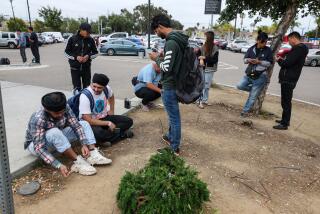Long-Distance Surcharge Proposed
- Share via
EAST PALO ALTO, Calif. — Long-distance callers could face an additional 0.4% surcharge on their bills starting later this year under a proposal embraced by President Clinton on Monday to help provide low-cost telephone service to needy residents on Indian reservations.
The surcharge would add $17 million a year to an existing $5-billion federal program that helps impoverished Native Americans pay for phone service.
The proposal, expected to be approved by the Federal Communications Commission this summer, would allow 300,000 more low-income Native American families to buy basic telephone service for $1 per month, according to FCC Chairman William Kennard.
To Clinton, the surcharge is a way to close the so-called digital divide, the disparity in access to computers and information technology between rich and poor. Experts say that the gap in computers has been narrowed over the last few years but that disparities remain in teaching, training and basics such as the telephone service needed to gain access to the Internet.
Today, only 22% of households on Indian reservations have telephone service, according to Kennard. He said that the surcharge increase is not a tax increase but “a reinvestment in the network.”
The surcharge would be levied on long distance telephone companies, which could pass it on to customers, although it would be up to them to decide whether to do so, according to Gene Sperling, a White House economic advisor.
Clinton formally announced the initiative here Monday during a public appearance to highlight his efforts to bring the digital revolution to pockets of America that are lagging behind. Some details of the plan were made public by the White House on Sunday.
Joined by corporate and community leaders, the president announced more than $100 million in commitments to enhance digital opportunities to the disadvantaged, many of them in California.
Clinton’s visit here was part of his “new markets” tour, launched last summer, to spotlight economically depressed regions of the country and to promote business opportunities in such areas.
He said that he came to East Palo Alto “because even here in the Silicon Valley . . . there are many people who could be left behind.”
A recurring warning in many of Clinton’s speeches these days, no matter what the topic, is that during flush times it is easy to forget about unseen problems that remain.
“Doing the right thing will accelerate the strength of this powerful economic engine,” he said.
Despite the rapid spread of computers and digital technology in this country, not all regions have been touched by the cyberspace revolution.
For instance, East Palo Alto’s schools still have a 28-1 student-to-computer ratio, compared to a 5-1 to 7-1 ratio in most public and private schools, according to the White House.
“Every young person needs to know how to use this technology,” Clinton said, calling his digital divide initiative “a big priority.”
Sperling said other surveys show that 69% of families where parents or other relatives have bachelor’s degrees own home computers but only 15% of those homes where adults have less than a high school diploma do.
He also cited a similar statistic to highlight the digital divide: 80% of families with annual incomes of more than $75,000 own computers, while only 15% of those with yearly incomes from $10,000 to $15,000 have them. Access to computers in libraries and schools, however, has helped bridge the divide.
Later in the day, the president journeyed to the Navajo Nation reservation in Shiprock, N.M., to tout his initiative, becoming the first president ever to visit that reservation.
To further help families on reservations join the information age, Kennard said, the FCC is looking for ways to “redefine” long-distance calls made from reservations because most calls from such regions now are considered long distance.
Among the commitments announced Monday:
* A new “get connected” public service campaign to promote the benefits of learning high-tech skills. The ad campaign is to be developed by the Kaiser Family Foundation and Black Entertainment Television for broadcast on numerous networks and cable channels.
* A $15-million Hewlett-Packard commitment to expand digital opportunities in three communities, starting in East Palo Alto.
* A Gateway program to teach computer skills to 75,000 teachers, including all teachers in this community.
* A $35-million commitment by Qualcomm to expand opportunities in San Diego.
* 100,000 free America Online accounts, worth up to $26 million a year, to be made available to disadvantaged users.
* A major expansion by PowerUp to expand from 19 to 250 the number of fully equipped and staffed sites to give underserved youths access to technology and guidance on how to use it.
* Software donated by Novell to nonprofit organizations to help underserved Latino communities spread high-tech knowledge and skills.
More to Read
Sign up for Essential California
The most important California stories and recommendations in your inbox every morning.
You may occasionally receive promotional content from the Los Angeles Times.












